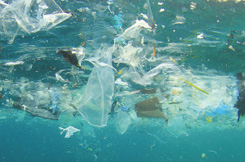The Great Pacific Garbage Patch
In 1997, Charles Moore and his crew sailed through the Pacific Ocean.
Halfway across, he noticed the water was cloudy, like soup. Soon,
they started seeing large areas of plastic rubbish floating in the water.
They found the Great Pacific Garbage Patch.
It’s a 700,000 square kilometre area filled with 750,000 tons of garbage.
80% of the garbage comes from Asia and North America.
The currents in the ocean collected it into one large region.
Most of the rubbish comes from fishing nets and plastic.
Both are extremely dangerous to marine life.
Plastic isn’t biodegradable. Instead, it breaks down into micro-size beads.
This makes the water very cloudy and blocks out the sun.
Plankton and algae need sunlight to grow. If their population is threatened,
larger fish and marine life that eat the algae won’t have enough food.
Also, sea animals eat rubbish because they think it is food.
Turtles eat plastic bags because they look like jellyfish.
Sea birds eat plastics because it looks like small fish.
Fishing nets trap and drown large sea life such as dolphins, seals, and sharks.
To protect the planet, people must be careful about their daily habits.
They have to use less plastic in daily life. They can use cotton bags for grocery shopping.
They should recycle all plastic, glass and metal waste.
Finally, people can pressure companies to use biodegradable materials for packaging.
Everyone has to make a serious effort to protect our planet.

